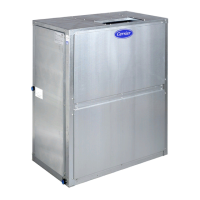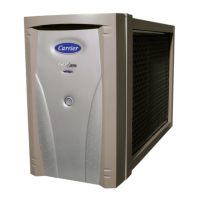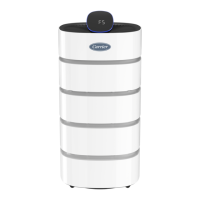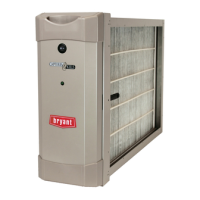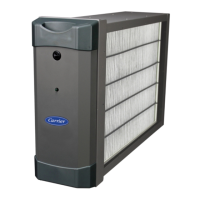ERV & HRV: User and Installer Manual
Manufacturer reserves the right to change, at any time, specifications and designs without notice and without obligations.
20
INSTALLER’S TROUBLESHOOTING (CONT’D)
Additional Details for Auto-Balancing Procedure
210 CFM ERV Models
The unit will reduce its airflow by 30 cfm if the max airflow during the auto-balancing procedure is 160 cfm or less to prevent the ERV core membrane
deformation due to very high static pressure (over than 1.3 in. w.g.).
All 210 and 230 CFM Models
Error E22 or E32 will appear if the maximum airflow is 120 cfm or less during the auto-balancing procedure (the unit will try to execute the
auto-balancing procedure 3 times before showing an error). Static pressure of ducting shall be reduced.
NOTE: 210 and 230 CFM models have a cooling fan in the electrical
box that can start if ambient temperature near the unit is over 104°F
(40°C).
WARNING DESCRIPTION SOLUTION
E60
Protection mode STEP 1: Perform general inspection of the unit (dampers, core, filters).
W22
Supply airflow
STEP 1: Unplug the unit. Perform a visual inspection of the supply damper system. Clean filters, distribution
registers and outside supply hood. Inspect ducting to ensure it is not squeezed or bent. Plug in the unit.
If STEP 1 did not fix the problem, perform STEP 2: Remove ducting of the supply path. On the LCD screen,
select MAX to check if the unit is able to reach the selected flow. If so, review the ducting path.
If STEP 2 did not fix the problem, perform STEP 3: On the LCD screen, select the MIN and MAX flow setting
values then reset the unit. MAX flow value will display on the LCD screen. If MAX flow is above desired
MAX flow, set MAX and MIN flows.
If STEP 3 did not fix the problem, perform STEP 4: Replace the supply blower and repeat STEP 3.
If STEP 4 did not fix the problem, perform STEP 5: Replace the electronic assembly.
W32
Exhaust airflow
STEP 1: Unplug the unit. Perform a visual inspection of the exhaust damper system. Clean filters, distribution
registers and outside exhaust hood. Make sure no non-return damper is installed in the exhaust hood since it
can freeze in winter. Inspect ducting to ensure it is not squeezed or bent. Plug in the unit.
If STEP 1 did not fix the problem, perform STEP 2: Remove ducting of the supply path. On the LCD screen,
select MAX to check if the unit is able to reach the selected flow. If so, review the ducting path.
If STEP 2 did not fix the problem, perform STEP 3: On the LCD screen, select the MIN and MAX flow setting
values then reset the unit. MAX flow value will display on the LCD screen. If MAX flow is above desired
MAX flow, set MAX and MIN flows.
If STEP 3 did not fix the problem, perform STEP 4: Replace the exhaust blower and repeat STEP 3.
If STEP 4 did not fix the problem, perform STEP 5: Replace the electronic assembly.
W52
Initial setting
incomplete
STEP 1: Press + or - to access the selection menu.
STEP 2: Complete configuration. (Refer to (AUTO-BALANCING PROCEDURE on p15) for more details).
W61
Protection mode
electronics
overheating
The unit is currently in protection mode. The power transmitted to the motor is deliberately reduced to
decrease electronics temperature. The unit will exit this mode by itself once conditions are back to normal. It is
normal to observe reduction in airflows during this period.
This condition should appear only when the unit is set in high speed and located in a warmer environment, for
example over 30°C (86°F).
CAUTION
!
OPERATIONAL HAZARD
Failure to follow this caution could result in degraded operation or
damage to the unit.
Make sure that no pieces of insulation material enter the unit during
installation. This could reduce airflow, generate noise and vibrations in
the unit.
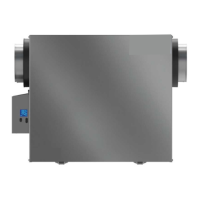
